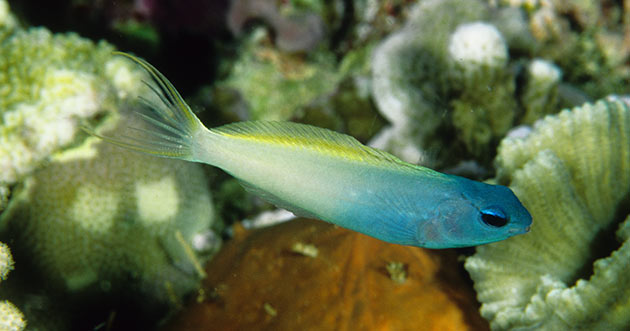
Are Lyretail Fang Blennies (genus Meiacanthus) worthy aquarium inhabitants and if so, how do you keep them? Firstly, because these Blennies are more conspicuous, in both color and behavior, Lyretail Fang Blennies tend to be more showy aquarium additions. However, if you are looking for a Blenny to help control algae growth, members of the genus Meiacanthus are not for you (stick with members of the genus Atrosalaris and Salarias).
In the past, I have found that some individuals (possibly as a result from holding and shipping stress) have a difficult time acclimating to the home aquarium. But this is not as common a problem now because many species of Lyretail Fang Blennies are being aquacultured. However, if you are buying wild caught Lyretail Fang Blennies, make sure they are eating before you bring them home. Lyretail Fang Blennies are active fishes that will slim down quickly if they are not feeding. Avoid individuals that have pinched-in bellies or atrophied dorsal musculature. Some individuals will incessantly swim up and down against the side of the aquarium. These individuals may be more difficult to feed, so I would avoid them. Remember, whenever possible, go for the captive-bred Meiacanthus as they more readily acclimate to captivity.
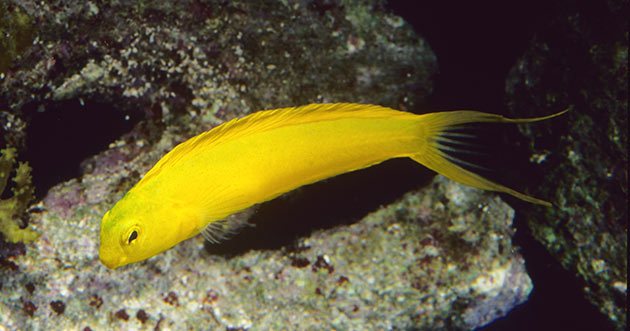
Meiacanthus ovaluensis |
At night, Lyretail Fang Blennies exhibit a mottled coloration. A Lyretail Fang Blenny that exhibits this coloration during the day is stressed. This may be due to aggressive tankmates, poor water conditions, or general ill-health. These fish may occasionally leap from an open top aquarium or into an overflow box. They have also been known to get sucked into filter intake tubes that lacks a straining device. Lyretail Fang Blennies love tight spaces in which to shelter. Breeders often use pieces of narrow diameter PVC pipe but snail shells, or holes drilled in a piece of live rock (or naturally occurring tunnels) will also be appreciated.
Feeding Lyretail Fang Blennies
Meiacanthus spp. should be fed finely chopped sea food (e.g., shrimp, squid), mysid shrimp, and vitamin-enriched brine shrimp. Frozen mixed seafood preparations are also an awesome staple food. But beware, their mouths are relatively small and their teeth are not adapted to masticating prey, so make sure food is small enough for them to swallow whole. I have seen them ingest, spit-out and bite at mysid shrimp repeatedly until the food was broken into ingestible pieces. Cyclop-eeze is another great food for Lyretail Fang Blennies and some individuals can be trained to accept smaller, pelletized and flake foods (this is the case for captive-raised individuals). For the rare Meiacanthus that will not accept any of these foods, try live brine shrimp – they rarely refuse Artemia.
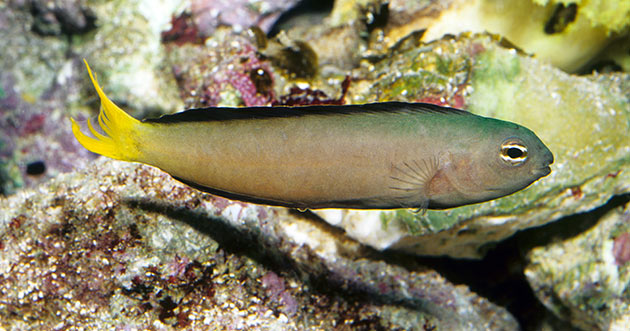
Meiacanthus mossambicus |
While most individuals will readily accept a variety of aquarium foods, Lyretail Fang Blennies tend to do best if housed in a setup with live rock where they can hunt tiny crustaceans and worms that live on the rock as well as feed on zooplankton produced by rock-dwellers. Another way to help ensure proper acclimation and a long, healthy captive life is to have a well-stocked refugium attached to the aquarium. If acquiring a wild-caught Meiacanthus, it may be advantageous to acquire a Meiacanthus Blenny after your reef aquarium has aged for six months or more. This will give the microfauna time to build up (that is, if you don’t have other microcarnivores in the aquarium to decimate the tiny crustaceans and worms that these Blennies also prey upon).
You should feed Lyretail Fang Blennies at least once a day (I prefer twice a day). Keep an eye on the fish’s girth and if they look skinny or if they begin to lose weight, feed them more. If they are not placed in a reef aquarium, then you may need to feed them even more to ensure adequate nutrition. Remember, these fishes will always do better in a setup that contains live rock. When feeding off the live rock, they will hover above the rock (sculling with their pectoral fins to maintain position) and scan it for prey. When they spot their quarry, they dart forward and wrest it from the rock.
Lyretail Fang Blenny Compatibility
While these Saber-Tooth Cats of the Blenny world will sink their teeth into the mouth parts of a hungry piscivore, they rarely if ever use their fangs to bite non-threatening tankmates. For this reason, they are wonderful for the placid community aquarium. Even with their formidable fangs, it is possible that aggressive fish tankmates will pick on Meiacanthus Blennies. I have seen individuals that were harried by larger Dottybacks and more aggressive Damselfish. A pestered Lyretail Fang Blenny will often hide constantly or hang in the upper corners of the aquarium and refuse to feed. A Lyretail Fang Blenny that is being harassed may exhibit a mottled color pattern during the day.
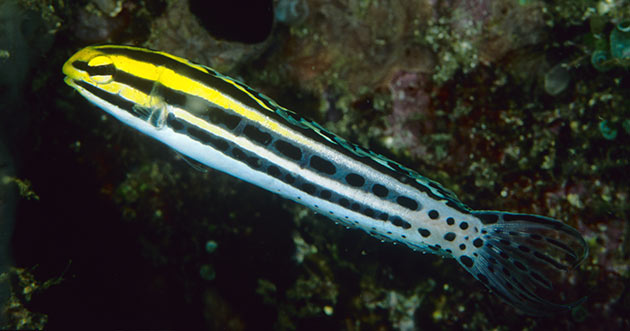
Meiacanthus grammistes |
For those that want to take the risk, it is even possible to keep Lyretail Fang Blennies with larger predators, like Lionfishes and Groupers. What typically will happen is that the predator will suck up the Blenny, get bitten and then ignore it from that point forward. That said, there is a chance that the piscivore may succeed in swallowing the Lyretail Fang Blenny before the Meiacanthus can inflict a life-saving bite or the actual act of ingestion may cause mortal injuries to the Blenny. While it can be done, it involves some risk to the Blenny.
Lyretail Fang Blennies can be kept singly, in pairs or in groups in the home aquarium. However, you should keep a single male per aquarium, especially if the system is less than 75 gallons in volume. A male will get along with other females, and females often do OK together (they may form dominance hierarchy within a harem), but a dominant male may incessantly harass subordinate males. If multiple male Lyretail Fang Blennies are housed in an aquarium that is large enough, the subordinates may be able to get out of the way of the more dominant male and avoid incessant harassment.
How do you tell the sexes apart? When these fish are mature, male Lyretail Fang Blennies tend to reach a greater length than females and have longer filaments on the rear edge of the caudal fin. It is also possible to keep congeners in the same aquarium. However, it is always a good idea to introduce congeners to the system simultaneously if the aquarium is of moderate size or smaller (less than 75 gallons).
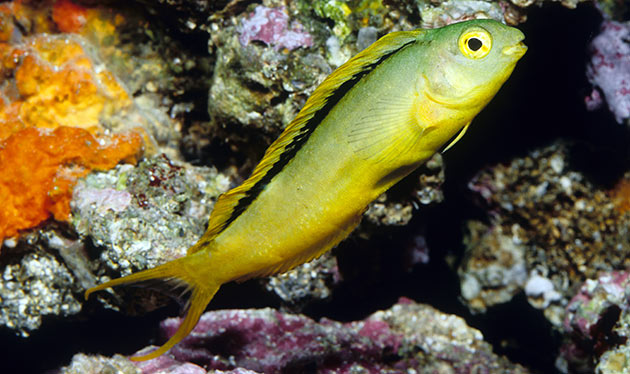
Meiacanthus tongaenesis |
Lyretail Fang Blennies in a Reef Aquarium
Meiacanthus spp. make wonderful reef aquarium fish. As mentioned above, these fishes do best in a system with live substrate. It is fascinating to watch them scan the live rock as they hunt for small prey items. They spend most of their time hovering or moving in the open and they are also not a threat to ornamental invertebrates. While the algae and detritus feeding Blennies (e.g., Cirripectes, Ecsenius, and Salarias) may occasionally nip at or even eat corals, Meiacanthus spp. pose no threat to sessile invertebrates.
Meiacanthus spp. are also wonderful “dither fish.” That is, a fish that remains in the open and incites more secretive species to “relax” and spend more time in full view. For example, I placed a Lyretail Fang Blenny in a setup with an Unarmed Perchlet (Plectranthias inermis). Within hours after adding the active Blenny, the little Perchlet began spending more time at the opening of caves and crevices. If they are “content,” Meiacanthus hide very little even when the aquarium lights are on.
Captive Spawning and Rearing of Lyretail Fang Blennies
Several marine fish breeders have spawning colonies of Lyretail Fang Blennies and sell the offspring in the aquarium trade. As mentioned above, captive-raised individuals are always the best choice for the home aquarium (they are often available at LiveAquaria®). Not only will these captive-raised individuals already be acclimated to captive conditions, it is important that we support those entrepreneurs that are making inroads into reef fish “farming.” These efforts also help take pressure off wild populations.
Breeders will keep pairs in smaller systems (e.g., 20 gallons) or harems in larger aquariums (e.g., 75 gallons), with PVC pipes that act as hiding places and nesting sites. Before spawning, the male will begin displaying to the female (it may be mistaken by some as aggression). The female’s abdomen will become noticeably swollen prior to spawning as the fish eggs hydrate. Meiacanthus spp. are demersal spawners and the reddish-brown to pinkish eggs are deposited in PVC pipe, in empty shells, or in reef crevices and are approximately 1.2 mm in diameter. The number of fish eggs in a batch can range from 100 to 300. The eggs typically hatch at night in 10 to 11 days (the incubation period is temperature dependent).
Part 1:
Classification and Biology of Lyretail Fang Blennies |
| |
Part 2:
Captive Care of Lyretail Fang Blennies |

Scott Michael
Scott W. Michael is an internationally-recognized writer, underwater photographer, and marine biology researcher specializing in reef fishes, and was the Banquet Speaker at our 2007 and 2008 Coral Conference and Frag Swap. He is a regular contributor to Aquarium Fish Magazine, Freshwater and Marine Aquarium Magazine, SeaScope, and is the author of Reef Fishes Vol 1, Vol 2, and Vol 3, Vol 4, and Vol 5., A Pocket Expert Guide Marine Fishes, A Pocket Expert Guide to Reef Aquarium Fishes, 101 Best Saltwater Fishes: How to Choose and Keep Hardy, Brilliant, Fascinating Species That Will Thrive in Your Home Aquarium, Reef Sharks & Rays of the World, and Aquarium Sharks & Rays. Having studied marine biology at the University of Nebraska, Scott has served as a scientific consultant for National Geographic Explorer, the Discovery Channel, and French educational television.
References:
Fishelson, L. 1975. Observations on behavior of the fish Meiacanthus nigrolineatus Smith-Vaniz (Blenniidae) in Nature (Red Sea) and in Captivity. Aust. J. Mar. Freshwater Res. 26(3): 329-341.
Losey, G.S. Jr. 1975. Meiacanthus atrodorsalis: field evidence of predation protection. Copeia. 1975(3): 574-576.
Moorhead, J.A. and Zeng, C., 2011. Breeding of the forktail blenny Meiacanthus atrodorsalis: broodstock management and larval rearing. Aquaculture, 318(1), pp.248-252.
Russell, B.C., Allen, G.R., and H.R. Lubbock. 1976. New cases of mimicry in marine fishes. J. Zool. Lond. 180(3): 407-423.
|